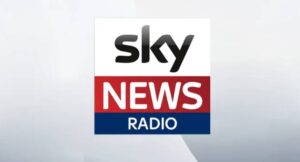Jaylee Williams needed to find somewhere to deliver her son.
The 19-year-old knew more about barrel racing on her horse Bet-n-pep than the complicated metrics of who takes what health insurance. But relief for Williams and her boyfriend, Xander Lopez, came when they realized Medina Regional Hospital – just 15 minutes from their home – accepted Medicaid, the federal-state program that covers medical costs for lower-income Americans. Provider groups an hour away in San Antonio had refused to take the insurance, she recalled while cradling little Ryker.
“You never know when something could happen,” Williams said, with Lopez adding, “I have no idea where we would have gone” without Medina Regional Hospital.
But the lifeline that the 25-bed critical-access hospital offered to Williams and Lopez could disappear in Hondo and other communities like it.
Rural hospitals across the United States fear that massive Medicaid cuts Republicans would have to consider under the current House budget proposal could decimate maternity services or shutter already struggling medical facilities in communities that overwhelmingly voted for Donald Trump.
Nearly half of all rural hospitals nationwide operate at a deficit, with Medicaid barely keeping them afloat. Already, almost 200 rural hospitals have closed in the past two decades, according to the Cecil G. Sheps Center for Health Services Research, part of the University of North Carolina at Chapel Hill.
Rural hospital leaders in Arkansas, Colorado, Kansas, Mississippi, Missouri and Texas who spoke to The Washington Post warned that the enormous cuts congressional Republicans are weighing could further destroy limited health-care access in rural America. Proposals to slash up to $880 billion over 10 years – which is expected to be accomplished largely by scaling back on Medicaid – would also affect those who do not rely on the program but do rely on the medical facilities that are financially dependent on the program’s reimbursements.
While Republicans are reluctant to acknowledge potential entitlement cuts due to possible political backlash, the House-passed budget proposal would almost certainly require Medicaid cuts, health-care analysts say.
“Every nickel matters,” said Benjamin Anderson, chief executive of Hutchinson Regional Healthcare System, which runs a rural hospital in Kansas. “It will cripple and close the health-care delivery systems that serve everyone.”
Heart attack and stroke victims may lose crucial time being ferried by ambulance to big-city hospitals, health-care experts say. Rural nursing homes may vanish, straining families in the poorest of regions. Those who are pregnant may have no choice but to drive long distances for prenatal checkups and to give birth.
Public perception often associates the health-care safety net used by more than 1 in 5 Americans with the urban poor. But rural children and non-elderly adults are more likely to rely on Medicaid or the Children’s Health Insurance Program (CHIP) than those in metro areas, according to the Center for Children and Families at the McCourt School of Public Policy at Georgetown University.
The possible cuts are an “existential issue” for rural hospitals, said Alan Morgan, chief executive of the National Rural Health Association.
“Medicaid cuts are going to result in rural hospital closures,” he said. “It’s just a question of how many.”
Maternity deserts and political consequences
Medina Regional Hospital sits in an 8,000-person agricultural town roughly an hour west of San Antonio, the drive between the two dotted with taxidermy signs, John Deere tractors and cattle. Per capita income comes in under $20,000 annually, according to the economic development director for the town.
The facility’s chief executive, Billie Bell, had considered closing the unit serving expectant mothers a few years ago. It’s a service the hospital already loses money on, Bell said, as the vast majority of obstetrics patients are on Medicaid, which does not reimburse the facility dollar for dollar for care. She managed to keep the unit open because she feared adding to the maternity health-care deserts in a state that far outpaces the nation in rising rates of maternal deaths.
More than 35 percent of U.S. counties don’t have birthing facilities or obstetric clinicians, according to a March of Dimes report. In Texas, that figure is even worse: Nearly half of the state’s counties are considered maternity-care deserts. Bell warned that cuts to Medicaid could shutter her unit completely.
“We’d lose a big heart of our community,” Bell said. “We provide care from the time someone is born until they die.”
Even if rural facilities manage to stay open but are forced to cut Medicaid-heavy services such as nursing homes or obstetrics care, more rural Americans – and Republican voters – will be left to deal with the consequences.
Some Republicans, such as Sen. Josh Hawley (Missouri) and Trump ally Stephen K. Bannon, have warned against gutting Medicaid, pointing to the vast number of Trump supporters who qualify for the program amid the populist wave that has transformed the GOP. The president has repeatedly said he will not touch Medicaid.
But he has also endorsed the House’s plan to find ways to cut spending across federal programs, which are expected to come out of the Medicaid program if lawmakers avoid cutting Medicare or Social Security. All three programs make up more than 40 percent of the federal budget. The House and Senate will work to reconcile their visions for cutting the federal budget in coming weeks.
The Republican Party suffered large congressional losses in 2018, the last time it tried Medicaid cuts, said KFF’s executive vice president for health policy, Larry Levitt, whose nonpartisan health-care research group surveyed Trump voters on Medicaid. Similar political reprisals could happen again, he warned.
“Rural America is Trump country,” Levitt said. “When they voted for Trump, I don’t think they expected cuts to their health care.”
In rural Hondo, whose slogan is “This is God’s country,” that kind of reaction wouldn’t be a surprise, said Mayor John McAnelly.
Hondo is the county seat of Medina County, where almost three-quarters of the presidential vote went to Trump. But if Medicaid cuts hurt Medina Regional Hospital, the answer would be pretty clear, the mayor said.
“Regardless of which party is in power, anytime you start doing those cuts, there’s going to be backlash,” McAnelly said.
Rep. Tony Gonzales (R-Texas), who represents Hondo, has spoken with Bell about the plight rural hospitals face.
When asked to comment, his office pointed to a letter he had sent to House Speaker Mike Johnson (R-Louisiana) urging him to support a budget that tackles waste without harming critical programs that support Americans.
“Slashing Medicaid would have serious consequences, particularly in rural and predominantly Hispanic communities where hospitals and nursing homes are already struggling to keep their doors open,” Gonzales and other representatives wrote.
About 3 in 4 rural residents said Medicaid funding should increase or stay the same, KFF found in a poll conducted Feb. 18-25.
With broad support for rural hospitals, there are likely to be carve-outs to protect them in a Republican reconciliation bill, said Brian Blase, an influential voice in the Medicaid debate. He served as a White House economic official in the first Trump administration and is now president of Paragon Health Institute, a right-leaning think tank, which is pushing for states to cover more Medicaid costs.
That support comes in part because when a rural hospital closes, communities don’t just lose their access to care – they often lose their economic lifeblood. Medina Regional Hospital is the largest employer in town and key to attracting businesses and young families essential to making Hondo thrive.
But items Republicans are proposing, such as work requirements, which often take people off Medicaid’s rolls, could impact its financial stability. During the coronavirus pandemic, states were required to keep people enrolled continuously in Medicaid to access enhanced federal funds. So when the public health emergency ended, millions were removed from Medicaid rolls, including many – particularly children – who probably remained eligible.
The Medicaid unwinding hit Medina Regional Hospital’s bottom line, said Kevin Frosch, the hospital’s chief financial officer. As people in his area came off the Medicaid rolls, they often got junk plans and were unable to pay for care, Frosch said.
Inside Medina Regional Hospital’s health clinic offices at the end of February, Chelsey Sullaway had her 37-week pregnancy checkup for her second baby, with her first daughter in tow.
Sullaway, who used to work at the hospital before becoming a stay-at-home mom, drives to Medina Regional Hospital for maternity care even though she lives in the San Antonio area. Sullaway isn’t on Medicaid, but she knows the hospital relies on its payments.
She voted red in the last election, but if the rural hospital she loved cut services, she would reconsider.
“It would impact votes for sure,” she said, as her daughter Vivian tried to climb on her.
‘Drinking the Kool-Aid’
As the sun set on a high school track meet in Hondo, two grandmothers watching their grandchildren race toward a chance at state glory laid out their opposing views on potential Medicaid cuts.
Leticia Garza said her mother told her never to talk about politics, because identifying herself as a Democrat wasn’t going to help her make any friends. Garza said she worries constantly about the cuts the Trump administration has made to federal services. She’s heard about women who are denied treatment for miscarriages and thinks about the future for her granddaughter.
When asked whether she thought this conservative small town would respond if Medicaid cuts impacted its health care, Garza said, “I’m hopeful that would change their votes.”
But her daughter, Nicole Garza, laughed, saying those voters have been “drinking the Kool-Aid too long.”
Across from the bleachers on the other side of the track, 66-year-old Sylvia Flores, an Air Force veteran who voted for Trump, said she trusted he would root out waste, fraud and abuse – rhetoric Republican leaders have often repeated when talking about potential Medicaid cuts.
Flores also noted that she had received quick care after a stroke at Medina Regional Hospital and hoped lawmakers “read before they sign” so cuts don’t affect “our little hospital.”
To Trump, she said, “Keep it up!”
Flores wasn’t alone in her concerns about waste, fraud and abuse – something the health-care community has experienced. Two administrators of the county’s local emergency medical service pleaded guilty in 2013 to fraudulently billing the government hundreds of thousands of dollars through Medicare and Medicaid for ambulance rides, including some that never happened.
However, health policy experts warn that even though there is waste, fraud and abuse in Medicaid, it doesn’t reach $880 billion. So while it’s important to go after bad actors, McAnelly said, the bigger picture matters.
“Go after the fraud, don’t throw out the baby with the bathwater,” the mayor added. “Everybody gets hurt on that. The leaders get hurt on it, the followers get hurt on it. The politicians, if you will, get hurt on it. The country gets hurt on it.”
Michael Haynie, who heads the local EMS company following the fraud fallout and works weekend shifts with his wife to keep the ambulances running, said he wasn’t sure that voters would connect the dots between Medicaid cuts and a decrease in access to hospital services. Even if they did, he said, people who qualify for Medicaid often have more pressing problems.
“Your typical Medicaid enrollee is not interested in what the news is saying about Medicaid,” Haynie said. “They’ve got more important things to worry about, like eating.” The Washington Post









